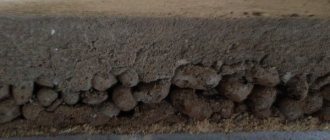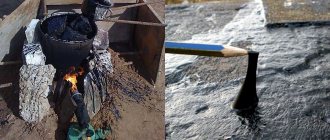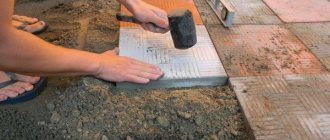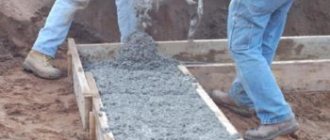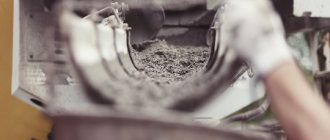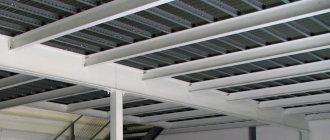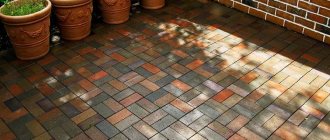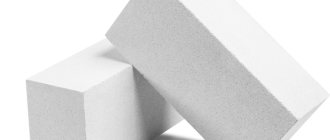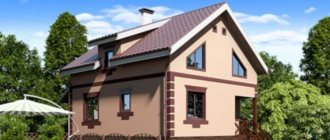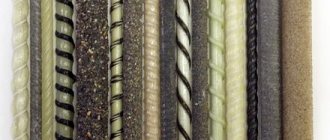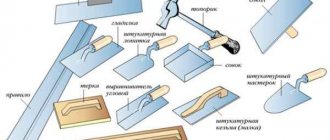Parameter " Concrete contact consumption"
» significantly depends on the porosity of the surface on which it is applied.
Basically, Betonokontakt is used for priming concrete surfaces (hence its name), but can also be applied to other surfaces: brick, drywall, concrete and ceramic tiles, old paint, etc. But even for one type of surface (for example, concrete) the consumption concrete contact can vary significantly.
Price of concrete contact, properties and characteristics, application instructions: Concrete contact
Concrete contact consumption per 1m2
Consumption of concrete contact primer per 1m2
for various surfaces. Let's divide surfaces depending not on their type, but on porosity - the ability to absorb water.
1. Porous surfaces: polished concrete and sand concrete, building bricks. For these surfaces, concrete contact consumption per 1 m2
is 0.3-0.5 kg. In addition, if the surface has significant porosity, it must be pre-treated with special deep penetration impregnations.
2. Surfaces with medium porosity: monolithic and high-quality concrete, concrete tiles, floor levelers (self-leveling cement floors), finishing bricks. Concrete contact consumption per 1m2 is 0.2-0.35 kg.
3. Low-porous surfaces, surfaces without pores: rubbed or reinforced concrete, ceramic tiles, old paint. For such surfaces, the minimum consumption of concrete contact per 1 m2 is sufficient - 0.15-0.25 kg.
Assessment of surface quality (adequacy of concrete contact consumption): the primer is applied evenly, there are no gaps, the sand is glued evenly and firmly. If there are gaps, or the primer is completely absorbed, or sand is easily removed from the surface, it is necessary to apply an additional layer of primer.
The best way to determine the consumption of concrete contact primer per 1 m2 for a specific surface is to do a test application. To measure the consumption of concrete contact per 1m2, separate a 1x1m square on the surface with masking tape. Take a sample - a small amount of primer (0.5-1kg). If you are casting the sample from a large container, be sure to thoroughly mix the primer first. Hang the sample together with the application tool (roller or brush). Apply the primer to ensure the required surface quality (see above). Once again hang the probe together with the instrument. The weighing difference is the exact consumption of concrete contact primer per 1 m2, even taking into account the material that remains on the roller or brush.
Thus, you will accurately determine the “concrete contact consumption” parameter and, accordingly, the amount of primer that you need to buy for your area.
Reducing consumption
To reduce the consumption of concrete contact primer on porous surfaces, they are pre-treated with special impregnations and a cheap deep penetration primer is used. An antiseptic is added to the wood.
Do not dilute the primer with water. When even a small amount of water is added, it loses its homogeneity and the quality of processing decreases. The plaster will crack and pieces will fall off.
Applying a thinner layer than specified in the instructions, although it will reduce consumption, will lead to a decrease in the quality of adhesion to the surface being treated and a deterioration in the waterproofing of the layer.
Purchasing low-quality (exceeded expiration date, frozen) or counterfeit products leads to exceeding the concrete contact consumption rate. Therefore, you only need to buy the product in branded containers with the date of manufacture and the country from which the product came. Check the certificate of conformity.
How to reduce concrete contact consumption
No way! “You don’t even need to try to do this.”
The price of concrete contact is too low to try to reduce the consumption of concrete contact to save money, and the consequences of reducing consumption can be the most disastrous: from loss of strength and cracking of the coating, to its complete peeling!
If you reduce the consumption of concrete contact soil, then adhesion - the adhesion of the new coating to the base - will decrease, but this is not the main thing. Many people forget that in addition to increasing adhesion, concrete contact has another purpose, which is much more important than the first - waterproofing.
Let us recall that the vast majority of coatings, before which it is recommended to apply concrete contact, are made on the basis of Portland cement or gypsum. Accordingly, when applied they are diluted with water. Portland cement and gypsum have one feature - mixtures prepared on their basis (mortars, sand concrete, plasters, etc.) can dry out if water quickly leaves the mixture.
Reference. How does drying occur:
- the amount of water in the mixture decreases to the point that the reaction of the cement (gypsum) stops, that is, the strength gain stops;
- strength does not increase, but shrinkage due to decreased water continues;
- Stresses arise that lead to cracking of the coating or its separation from the base.
In a word, you should not try to connect the parameters “concrete contact price” and “concrete contact consumption” - nothing good will come of it.
Before painting, plastering the walls, or performing other preparatory treatment, you first need to level the base as much as possible. And even if the characteristics of the composition allow it to be applied to an uneven base, it is better not to take risks and use a primer mixture. When finishing concrete in our time, Betocontact primer is often used, which significantly improves many characteristics of the concrete surface.
KNAUF
One of the most popular in the world of concrete is the KNAUF betokontakt mixture. This is a so-called dispersion, which contains pure quartz sand. KNAUF betocontact is used for substrates that do not absorb moisture well or are not moisture-absorbing surfaces at all. With the help of soil, low-porosity bases are prepared for plaster or putty. The technical characteristics of the KNAUF betokontakt solution allow the use of the material for applying gypsum stucco.
Let's take a closer look at the technical characteristics of the material:
- Used for internal processes
- Good alkalinity
- Applied mechanically or using a fur roller
- Consumption of KNAUF betocontact – 0.25-0.35 kg per 1m2 (per 1m2 if the material has not been diluted)
- Drying time - 24 hours
The composition of the KNAUF betokontakt soil allows the solution to be used for concrete or monolithic foundations, reinforced concrete structures, plasterboard or expanded polystyrene slabs. Also for gypsum products or before applying gypsum-lime plaster.
Peculiarities
Often the adhesion of two different types of materials during finishing is quite problematic. Thanks to the soil, for example, betokontakt, the adhesion rate increases significantly even when the surface practically does not absorb moisture. The primer consists of cement, sand, and other special additives that create a rough layer formed by the sand, and the cement allows the mixture to adhere well to the walls.
Betokontakt Knauf primer is made only from safe, environmentally friendly components that do not emit unpleasant odors, do not harm human health and do not spoil the appearance of surfaces.
Characteristics and use
You can use Knauf primer without diluting it with water; just shake the canister and the mixture is ready for use. It is recommended for use for the following purposes:
- improving the adhesion of plaster or tiles to concrete walls;
- facilitating the plastering process;
- preventing the destruction of the painted layer on the plaster;
- hiding all cracks and seams;
- extending the service life of the finishing material, which will not crumble prematurely.
The Knauf brand primer contains acrylic, thanks to which the mixture becomes sufficiently resistant to moisture. The acrylic content does not have a negative impact on the quality of base preparation; in many cases this becomes a significant advantage.
The manufacturer produces the following types of composition:
- large and small fractions of the mixture;
- a universal primer, as well as one intended directly for external or internal use.
Modern manufacturing technology, as well as a formulation thought out by professional specialists, allows the soil to remain unharmed and perform its functions for many decades. Just a few hours after the primer is applied to the surface, finishing can begin. Drying time is minimal, it depends on temperature and air humidity. If you ventilate the room, the drying time will be much shorter than in a closed room. The soil has all the necessary certificates; these products fully comply with GOST and are of high quality.
The primer is pink in color and saturates walls and floors that cannot absorb leveling compounds or glue. This polymer dispersion primer can be used even when the old finishing material is not removed, but simply covered.
This primer from Knauf can be used for application not only on concrete, but also on:
- expanded polystyrene boards;
- ceramic tiles;
- drywall.
The solution that is laid on top of the soil dries evenly. Preliminary application of the primer mixture makes it possible to significantly reduce the consumption of paint or plaster per 1 m2. This composition has antiseptic characteristics, thanks to which pathological microflora, for example, fungi or mold, will not appear on the walls or floor. After drying, the primed areas become vapor-permeable, due to which the room will be ventilated and there will be air exchange.
It is necessary to prime at positive temperatures, but when the mixture dries, it will retain its technical characteristics in the temperature range from -40 to +60 degrees. The acid-base balance of the composition is neutral, it does not contain toxic components, so it can be used even in places where there is practically no ventilation, the primer will not cause any harm to people living in the room. You can purchase soil in containers of 5 and 20 kilograms. The mixture retains its original properties for one and a half years if the packaging is sealed.
Review of the best popular primer brands
In terms of purpose and operating principle, they are all approximately the same. The difference lies only in the minor components that manufacturers add in order to improve the quality of their product, distinguish it from the crowd and promote it to the forefront. The brands in greatest demand today are:
- Birss;
- Dali;
- TEXT;
- Knauf.
1. Birss concrete primer has established itself as a good domestically produced building material. It is produced in plastic buckets with a reliable metal handle with a volume of 10 and 20 kg. Having a water-dispersion base with the addition of finely calibrated fillers, it helps not only to create a developed rough surface with excellent adhesion, but also to stabilize the coating by eliminating microdefects.
- Color of the resulting film: transparent, matte.
- Consumption: 300-350 g/m2.
- Application temperature: from +5 to +35°C.
2. Adhesive acrylic Dali - another creation of Russian manufacturers. You can buy it in 3 weight options: bucket with a capacity of 3.5, 6 and 12 kg. Dali is based on modified acrylic copolymers, quartz filler, special additives and an antiseptic that actively prevents the appearance of fungus and mold.
- Color: pinkish
- Consumption: 1 l per 3-5 m2.
- Temperature: +10 to +35 °C.
3. The TEX company (Russia) has long been producing products that are good both in terms of quality and price. Contact concrete for treating large surfaces is best purchased in buckets of 6, 12, 18 kg. TEX Universal 3 kg is an excellent solution for small bases. The main ingredient is a copolymer acrylic dispersion, and technological additives and fillers improve the properties. Can be used for both interior and exterior work.
- Film color: colorless.
- Consumption: 5-7 m2/kg. (7-9 m2/l).
- Temperature: from +5 to +35°C.
4. Primers from Knauf (Germany) are often purchased by craftsmen, since they meet all the parameters for performing a professional finish. When making concrete contacts, the manufacturer uses exclusively sifted quartz sand, the fractions of which come in 2 types: 0.3 and 0.6 mm. The first variation is ideal for treating the base before puttying, adhesive wallpaper, or painting. The second type is better to prefer before plastering. Available in plastic buckets weighing 5 and 20 kg.
- Color: light pink.
- Consumption: 0.2-0.35 kg/m2.
- Temperature: from +5 to +25°C.
How to apply the composition?
Correct use of concrete contact implies:
- preliminary cleaning of the surface;
- mixing the solution in order to lift heavy particles (sand, cement) and balance the composition;
- applying the primer with a brush or roller in one layer (a second layer is necessary if the coating is characterized by unevenness);
- waiting until completely dry to ensure maximum adhesion and continue finishing.
In the modern world, there are a huge number of building materials that have certain properties. Primers, which are an indispensable material when carrying out preparatory work, differ in their properties and the substrates on which they are applied. Concrete contact primer is a universal product, and today I will tell you about its technical characteristics, composition, where it is used and what its consumption is per 1 m2. In addition, we will find out why concrete contact is needed and for what work Knauf concrete contact is suitable.
Consumption
Many people are wondering what the primer costs are? The consumption of high-quality Knauf concrete contact per 1 m2 depends on several parameters. Experts say that the consumption of the mixture is determined by the absorption rate of the base, the type of surface, as well as its condition. On average, soil consumption is as follows:
- when applied to porous concrete, sand concrete and brick, the cost is 500 grams per square meter. By using impregnations that penetrate deeply into the base, costs can be reduced;
- with average porosity of monolithic concrete, the consumption is 350 grams per square meter;
- with a minimum number of pores, as well as in the case of application to a painted surface, the costs will be approximately 150-250 grams per square meter.
In order for adhesion to be maximum, it is necessary to take into account the condition of the base. If gaps begin to appear during priming, and also if the walls absorb the primer mixture very quickly, it is advisable to prime in two layers; the second layer can be applied only after the first layer has completely dried.
To understand how much primer will be used in total, it is necessary to conduct a test. To do this, a small volume of the mixture is weighed and the Betocontact primer is distributed per m2 of ceiling or wall. After this, the total number of square meters that need to be primed is calculated. Thanks to this test, you can easily calculate how much material you will need to buy.
Many people are interested in whether it is worth saving concrete contact and using it less than the manufacturer recommends? Experienced craftsmen have learned in practice that saving soil is unacceptable. This often leads to a significant deterioration in the quality of base preparation, as a result of which the surface will be fragile and adhesion to the finish will be insufficient. The finishing material may begin to delaminate, crack and crumble.
It is also very important to consider how to properly dry certain materials. For example, if sand concrete is dried at the wrong temperature and is not moistened in time, the walls will dry out, as a result of which even a sufficient layer of soil will not prevent cracks from appearing and the plastered layer from falling off. This will lead to additional costs and rework of the entire work. To avoid this, you must strictly follow the manufacturer's recommendations.
Mixing concrete contact with deeply penetrating soils is allowed, but then it must be used undiluted. If you apply the primer mixture using a spray gun, the consumption will increase slightly. Knauf recommends waiting 12 hours after applying the primer to allow it to dry completely before applying the finishing material. At normal temperature and air humidity, drying time is 3-4 hours.
If you use hand tools such as a brush, roller or brush to apply betocontact, it must not be diluted with water. And when spraying mechanically, you can dilute the soil in a ratio of 2 to 1.
- Where is it used?
- How to calculate?
- What else does consumption depend on?
- Norm
- How to prepare the surface?
- How to apply it correctly?
- Peculiarities
- Manufacturers
- Tips and tricks
During repairs, it is impossible to do without a material that helps connect two completely incompatible elements. In this case, concrete contact comes to the rescue, which helps the finishing materials to firmly attach to the wall or to each other. The components for its production are quartz sand, very strong glue, and acrylic. Thanks to this composition, you can get good adhesion and simplify the finishing process.
The concrete contact primer will make the surface rougher, and after that you can begin processing with the desired material.
Using this solution is an activity that requires a lot of attention. There are many nuances that are worth remembering. But it is impossible to do without this primer when you need to finish concrete walls or ceilings. Do not forget about the main rules for applying the mixture. And of course, you need to know how to calculate how much primer floors, ceilings, and other surfaces require. This will allow you to immediately purchase the required amount of solution for your area.
Working with soil
The instructions state that any primer should be applied to a clean, dust-free surface if possible. As already mentioned, the temperature should be above +5 ºС. The solution is liquid, conductive and it is advisable to turn off the power to the room before starting work.
The composition comes to the retail chain in a ready-made form and does not require additional actions, except that before work it must be thoroughly mixed with your own hands. It contains sand, which tends to settle, so it is necessary to mix not only before use, but also during operation.
Important: you can apply concrete contact with a foam roller, but professionals prefer to work with a brush, since it is easier to get into hard-to-reach places with a brush. The use of a spray gun is allowed, but with a nozzle of the appropriate size.
To make the primed surface stand out against the general background, the solution is usually tinted pink. Drying time can vary from 2 to 4 hours, depending on the air temperature and the level of ventilation of the room.
Composition consumption
The consumption rate of concrete contact per 1 m2 depends not on the type of base, but rather on its porosity, that is, on its ability to absorb moisture.
- The porous material has high moisture absorption characteristics; 0.35 - 0.5 kg of soil is consumed on it. This includes pre-putty, sand concrete, building bricks and some types of natural stone. Before using concrete contact, it is recommended to treat these surfaces with some kind of deep penetration primer. If wood is treated, an antiseptic is used.
- Materials with medium porosity absorb less moisture and the consumption rate of concrete contact per 1 m2 is correspondingly lower, from 0.2 to 0.35 kg. These include monolithic blocks of high-grade concrete, most self-leveling floors, concrete tiles and some types of facing bricks.
- Soil is especially valued for its ability to process low-porosity and smooth surfaces; approximately 0.15 - 0.25 kg per 1 m² is consumed on them. These can be worn-out concrete monoliths, iron or tiles, old stained paint and even glass.
Advice: the quality of the treated surface is determined simply; after the composition has completely dried, visually the coating should be uniform and have no gaps. Next, you need to run a spatula over it, if the sand does not crumble, everything is fine, otherwise you should cover it again.
How to reduce composition consumption
To put it simply, no way. Experts do not even advise experimenting in this direction. The price of concrete contact is quite reasonable and there is no need to try to remove the foam from places where it is not customary to remove it; such attempts may cost more later.
At a minimum, the plaster layer may crack and lose its decent appearance, but it may even lead to complete peeling of the coating. This type of soil, in addition to actually increasing adhesion, also has decent waterproofing characteristics. And most plaster compositions and putties are diluted with water.
If a wet composition is applied to a poorly primed surface, moisture from the solution is absorbed into the base and the hardening process stops, and shrinkage continues. As a result, the plaster layer cracks and falls off. The highly porous base literally sucks out water, and the concrete contact prevents this process.
Tip: sometimes you can find “experts” who recommend diluting the soil with water. So, acrylic compounds do not dissolve with water, the soil simply becomes heterogeneous and in fact it will be ruined.
The video in this article provides additional tips on the topic.
How to calculate?
Betonokontakt primer can be used not only on concrete walls, but also on any other surface. You need to know that there are features of consumption; it can vary depending on the type of surface on which it is used. For example, when working with concrete walls it is one thing, but when working with brick or plasterboard it is completely different.
Let us divide the surfaces depending on such a parameter as porosity. So, there are three types of such surfaces.
- Porous
- among them brick, concrete with sand and polished. When working with these materials, the consumption of concrete contact per 1 m2 will be about 0.3 – 0.5 kg. In addition, if the surface has high porosity, then it must be treated with special deep penetration impregnating materials. - Medium-porous
- this can be monolithic concrete, concrete tiles or self-leveling flooring. Here the norm per 1 m2 is: 0.2 – 0.35 kg. - Low porosity
- for example, ceramic tiles, troweled concrete or paint. For them, it will be enough to use about 0.15 - 0.25 kg of material.
Traditionally, the following surface options are distinguished:
- Poreless or low porosity. These include: ceramic tiles, painted walls, rubbed concrete. On such surfaces, the consumption of Concrete Contact per 1 m2 will be minimal: 0.15 - 0.25 kg. The primer is easy to apply in an even layer and, as a rule, does not require additional leveling.
- Surfaces with medium porosity These are high-grade concrete, monolithic structures, self-leveling cement floors, facing bricks or concrete tiles. Here the consumption will be higher and will be 0.2 - 0.35 kg per square meter.
- Porous surfaces. This type includes sand concrete, wall bricks and similar materials. Consumption of Betonkontakt per 1 m2 is 0.3 - 0.5 kg, which is explained by the need to fill the pores. It should also be borne in mind that if the surface is highly porous, then it must be treated with special impregnations, otherwise coating with a primer will not lead to the desired results. In addition, the absorption of the primer into the pores leads to an uneven layer, which requires regular trimming.
The best practical way to determine the consumption of Concrete Contact is to test treat a section of the surface. To do this, you can stick masking tape on the wall, forming a meter by meter square. You will need a strictly defined amount of primer, approximately 0.5 - 1 kg (prepared). It is necessary to apply the primer until a smooth, uniform surface is obtained, without drips or gaps.
Once the square is finished, weigh the remaining primer and subtract it from the initial weight. The result is the consumption of Concrete Contact per 1 m2.
Is it possible to reduce material consumption?
Theoretically, yes, but you shouldn’t do it. The cost of Betonkontakt is not so high as to save much. But a lack of primer can lead to a number of negative consequences: cracking of the decorative coating, peeling and deterioration of waterproofing properties.
Thus, the primary task is to ensure high-quality application of the primer, and not to save it.
In the modern world, there are a huge number of building materials that have certain properties. Primers, which are an indispensable material when carrying out preparatory work, differ in their properties and the substrates on which they are applied. Concrete contact primer is a universal product, and today I will tell you about its technical characteristics, composition, where it is used and what its consumption is per 1 m2. In addition, we will find out why concrete contact is needed and for what work Knauf concrete contact is suitable.
Norm
In order to obtain information about the amount of primer, you need to use a so-called sampler. To do this, you need to select a 1x1 meter square, as well as a certain amount of solution that will be applied. It is necessary to weigh the mixture along with the container in which it is located. After this, you can begin to apply concrete contact to the surface. During the finishing process, we check whether the mixture holds tightly, and if something is wrong, correct it.
After work on the entire square is completed, you can weigh the solution again. The difference between these numbers will be the consumption rate for your surface. It is worth paying attention that the filling of even this test square should be even and smooth, without any gaps.
If there is not enough mortar in any place, this will manifest itself in the shedding of sand and cement. In such a situation, it is better to add another layer, which, as a rule, requires 20-30 percent less primer.
Epoxy and polyurethane mixture
Among concrete primers, several materials can be distinguished. Epoxy primer is characterized by improving the strength of the surface after its application. In addition, the composition can be one-component or two-component. Let's look at the benefits of these solutions:
Polyurethane primer is very similar to epoxy mixtures and has the same excellent properties. Typically, polyurethane primer is used for work in industrial areas. It is chemical resistant and perfect for garage use. Despite its price, this primer is very economical, because to acquire the necessary properties, applying one layer is enough.
How to reduce solution consumption?
Since the peculiarity of concrete contact is that its cost is not so high that in order to save and reduce its consumption, it is better not to ask this question at all. The consequences of reducing consumption can lead to the fact that the strength will be significantly lower, the coating will begin to crack, and in the future it may completely peel off.
As the amount of concrete contact decreases, adhesion—the interaction between the base and the new coating—will also decrease, but even this is not the worst thing. Do not forget that one of the purposes of concrete contact is waterproofing.
Many coatings that interact with primer are based on gypsum or Portland cement, and, accordingly, they must be diluted with water.
If water quickly leaves the mixture, the coatings will dry out. This is exactly what concrete contact does not allow you to do, so it is better to get rid of the idea of how to calculate the soil in order to save more.
How to prepare the surface?
In addition to the characteristics of the surface, the primer consumption will depend on how correctly you prepare it before work. First, you need to clean the work site from dust or various types of contaminants. If there are places that have already begun to peel off or crumble, then it is better to deal with them immediately and remove them. Any existing unevenness must also be covered with plaster.
The peculiarity of concrete contact is that it cannot stick to a surface that is greasy. If there are such areas, then it is better to wash and degrease them, only then proceed. Places where there is paint can be washed with a damp sponge; if this is not possible, then it is better to cover them with a regular primer. This procedure makes it possible to significantly reduce consumption, since the soil will fill the places where there are cracks.
After the processing is completed, you need to remove small specks, then you can be sure that the concrete contact will adhere tightly to other materials.
How to apply it correctly?
After the package has been opened, the primer must be mixed well. The consistency of this solution is somewhat similar to paint, and due to the fact that pigment is introduced into it, the concrete contact is very clearly visible on the surface. It is better not to apply primer if the air temperature is below 5 degrees Celsius.
This is because at lower temperatures the humidity can become high. In addition, under such conditions it is impossible to guarantee that the primer will set well and dry.
The primer can be applied using a roller, a special brush and a spatula. It is necessary to apply a thin layer of the solution; it is better to use a wide brush for this. After this, you need to leave it for some time to dry. You can check whether the surface is completely dry using a special iron spatula. You just have to run it along the concrete contact and see if anything crumbles. It is worth noting that in order for further work to be carried out, you need to wait at least a few hours.
In this matter, finishing work cannot be postponed. The longer the break, the greater the likelihood of dust appearing on the surface, and this leads to deterioration of adhesion. If more than 48 hours have passed since the primer was applied, you need to cover it with deep penetration primer.
You can cope with this process yourself without calling a construction team. The main thing is to follow the application technology, and to ensure that the temperature conditions are stable during the application and drying of the concrete contact.
DIY primer application
First you need to clean the surface of debris and dirt.
, dust and everything else. Next you will need a roller or brush.
in an even thin layer using a roller
on the wall. Corners and hard-to-reach places are treated with primer using a brush.
When performing work, you need to monitor the temperature in the room. It should not be below +5 °C.
Now the main job is done and you can rest a little. You must wait until the concrete contact is completely dry
. This is very important because if it is even a little wet, it will significantly reduce the quality of adhesion.
Complete drying of the concrete contact usually occurs after 5-6 hours.
. After this time, you can begin further finishing.
Do not delay the continuation of finishing work
, because after more than two days the surface will dry out and become dirty.
Now that you have learned about this wonderful type of primer, your renovation will be easy and enjoyable.
Video review of concrete contact primer.
When starting a renovation, every good owner first of all calculates how much and what materials he needs. We are, of course, not talking about exact calculations, but in general terms it is advisable to have an idea of how much the repairs will cost. Primers for concrete surfaces are used almost everywhere, and the question of what is the consumption of concrete contact per 1 m2 interests many. In this article we will try to answer the most common questions regarding this type of soil.
Peculiarities
This material has long been appreciated by builders for a number of its advantages.
- High drying speed, which is important during repairs when everything needs to be done as quickly as possible.
- Moisture resistance. This is especially useful for those who do floor screeding.
- The service life of such material is 80 years. This is exactly the time when, if applied correctly and following all the rules, according to manufacturers, you don’t have to worry about the full performance of the primer’s functions.
Manufacturers
There are either Knauf, which have been on the market for quite a long time and produce only high-quality products. Consider the Knauf primer, which is popular among buyers. This material is used when working with dense surfaces that have rather low absorbency. It can be:
- compacted concrete;
- reinforced concrete structures;
- plasterboards.
Knauf manufacturers have tried to ensure that the material has a high level of resistance to alkalis. In addition, this solution can be not only the basis for applying wallpaper glue, putty and other mixtures. It will also be useful when finishing the base and will protect it from various influences.
Features of Knauf are:
- high vapor permeability;
- consumption of finishing materials is reduced;
- there is protection against bending and mold;
- has dirt-repellent properties.
Manufacturers of 20 kg Knauf packaging made sure that the buyer was satisfied and returned to this brand more than once. Due to the fact that the jars with the solution are quite spacious, there is no need to go to the store several times in search of the right primer.
When choosing concrete contact, you must be guided by several factors. First of all, it must be a manufacturer that has proven itself. The cost of the material should not be too low compared to others. In addition, you should carefully study the expiration date indicated on the packaging.
By the way, if the primer was made more than a year ago, you should refuse to purchase it. In addition, you need to pay attention to the homogeneity of the mixture. If there are lumps in it, then it is a low-quality product. And lastly, concrete contact cannot be stored at low temperatures, this applies to both the store and the home.
To learn how to use the concrete contact Ceresit CT 19, see the following video.
During repairs, preparatory work is always carried out: plastering, leveling, painting, etc. For better adhesion and reliable preservation of the material, primers are used. One such composition is concrete contact. The consumption of concrete contact per 1 m² of treated area depends on several factors.
When combining two materials with different characteristics, problems arise in most cases. The use of primers can correct the situation even with the most problematic surfaces. Such compositions also include concrete contact. After its application, thanks to the special composition, the surface becomes rough, which significantly increases adhesion.
Manufacturers of concrete contacts use environmentally friendly materials. The mixtures do not have a pronounced odor and do not change the appearance of the walls.
The composition is applied after thorough stirring. The finished primer is used for the following purposes:
For example, primer from the manufacturer Knauf contains acrylic, which provides moisture resistance and high adhesion.
Concrete contact primer significantly simplifies working with different materials and allows you to reduce the consumption of finishing materials. Most often it is used for concrete surfaces, but good results have also been seen when applied to brick and drywall.
The consumption of concrete contact per m2 is calculated depending on the type of surface to which it is applied. Its porosity is of decisive importance - this will determine how quickly the composition will be absorbed. The higher the degree of absorption, the greater the consumption.
Surfaces have different absorbencies:
The user cannot always determine the degree of surface porosity. To establish the consumption of concrete contact in such cases, a test treatment is carried out. In the experimental area, the boundaries of 1 m² are determined using tape. Take a fixed amount of soil, for example, 1 kg. Begin to apply a layer to the selected area until a uniform coating is obtained. The remainder is weighed, then the consumption of concrete contact per 1 m² of wall is calculated.
Features of application
The effectiveness of concrete contact depends on a number of conditions
. First of all, it depends on the correct execution of several steps:
- Preparing the surface, removing dust and dirt, removing old finishes. If the defects are minor, then plastering is not necessary.
- Treating walls with impregnation or a simple primer mixture before using concrete contact.
- Waiting for complete drying.
- Prime the surface with a thin layer of concrete contact using a roller.
- Allow the mixture to dry within 2 hours.
- Applying the second layer (their number depends on the condition of the surface, and each subsequent layer must dry well).
The surface is ready for puttying or finishing work.
Compared to other primer mixtures, the consumption of concrete contact per 1 m² is about 0.25−0.3 kg. Calculating the required amount is not difficult at all: the consumption rate is multiplied by the quadrature of the surface being treated.
Online calculators are available on specialized websites, and their use is completely free. Qualified builders took part in the development, so the likelihood of error is reduced to zero. By going to the desired website and opening the online calculator, you just need to enter the necessary parameters:
Many consumers do not believe that priming with concrete contact is necessary, and in order to save money they refuse this procedure. But if quality and the elimination of further problems are a priority, then applying a primer is necessary. The savings are insignificant, and it is sometimes very difficult to eliminate unpleasant consequences.
Preparing walls for painting, plastering or other processing always implies maximum leveling of the base. If formally, according to the descriptions of the compositions, it turns out that they can also lie on uneven surfaces, it’s not worth the risk. When finishing concrete, concrete contact primer comes to the rescue.
Conclusion
As can be seen from the above data, the consumption of concrete contact per m2, taking into account the cost, is relatively small. Trying to save money, you risk running into repeated repairs. Few people can be satisfied with cracked and crumbling plaster in places; in this case, cosmetic measures will not be enough; you will need to start all the repairs from scratch, and this will entail double the cost estimate.
Content
Concrete contact is a primer that is used to ensure good adhesion of the base and plaster or finishing materials. It transforms a smooth surface into a rough one, allowing the coating to reliably adhere to the wall. The mixture includes quartz sand, acrylic and special glue. The consumption of concrete contact per 1 m2 of base area may differ slightly, so special attention should be paid to this point.
| Sales capacity, kg | Average consumption, kg/m² | What area can be applied to, m² | |
| Prospectors | 20 | 0,2 — 0,3 | 67 |
| Phoenix | 20 | 0,2 — 0,3 | 67 — 100 |
| Ceresit CT19 | 10l – 15kg | 0,2 — 0,5 | 20 — 50 |
| Feidal | 20 | 0,2 | 100 |
| Small wall | 20 | 0,3 | 67 |
| Large wall | 20 | 0,3 | 67 |
Costs are almost always indicated by the manufacturer on the product packaging. But if they are not here, you should consider the average indicators to determine the required volume of material for purchase. The consumption of concrete contact per 1 m2 will depend on several points. This is the manufacturer, the composition of the mixture, the characteristics of the base being treated.
Peculiarities
Adhesion between two different types of materials often causes serious problems during finishing. Primers such as concrete contact increase adhesion, even if the base does not absorb moisture well.
The composition of such materials includes sand, cement and some special additives (they are determined by the mixture recipe). The rough outer layer created by the contact primer is formed by the sand, and the cement helps it better adhere to the surface.
During production, only environmentally friendly materials are invariably used, which do not emit bad odors and do not spoil the appearance of the walls.
Application and characteristics
The material can be used once after shaking. It is recommended to use it to:
- prevent paint deterioration on dry plaster;
- make plastering easier;
- improve the adhesion of tiles to concrete walls;
- close seams and cracks;
- reduce premature shedding of finishing materials.
Knauf brand primer contains acrylic, which gives it increased resistance to moisture. At the same time, the quality of surface preparation is no worse than that of most other auxiliary materials (and sometimes better).
Produced:
- both a universal mixture and one adapted directly for interior work;
- both large and small fractions.
A carefully thought-out formulation and production technology allows the primer to remain unharmed for many decades.
After applying it to the wall, it is enough to wait a few hours and then immediately proceed to the main surface finishing.
German concrete contact is painted pink. It is designed to impregnate substrates that are not able to absorb glue or leveling mixture. The polymer dispersion composition helps even in cases where the previous finish is not dismantled, but is covered over.
Concrete contact is suitable for lubrication:
- tiles;
- expanded polystyrene;
- drywall.
The leveling solution placed on the primer dries evenly. Thanks to pre-treatment, it will be possible to reduce the amount of plaster or paint used. Concrete contact has antiseptic properties. It effectively suppresses the occurrence of foci of any pathological microflora. When used, the permeability of the intermediate finishing layers increases, and because of this, the ventilation of rooms and their exchange of air with the outside world is facilitated.
Knauf material has a neutral acid-base balance. It retains its positive characteristics even in frosts of -40 degrees and in heat up to +60 degrees. Due to the absence of toxic components, Knauf concrete contact can be used even where ventilation is unsatisfactory - there will be no harm to the health of household members.
In the most practical container (5 or 20 kg), the primer retains its characteristics for up to 1.5 years, unless the seal is broken.
Read more about Knauf concrete contact
- in the next video.
Dense substrates that do not absorb moisture well Drywall
Surface
Ceilings Walls
Type of subsequent coating
Priming before plastering work Priming before laying tiles
Characteristics
Consumption 0.2-0.3 kg per 1 sq. m Readiness of the surface for subsequent coating 2-3 hours (at temperatures from +15 to +25°C) Mass fraction of latex by dry residue, not less than 60% Shelf life from the date of manufacture 12 months
Purpose
It is used for interior finishing work in all types of buildings and structures (A-B), including rooms where a wet disinfection regime is provided, except for surfaces that have direct contact with drinking water and food products. Designed for pre-treatment of dense, poorly absorbent substrates (monolithic concrete, concrete blocks, concrete ceilings) before applying gypsum, gypsum-lime, plasters. As an adhesive primer before laying new ceramic tiles on old ones using tile adhesive (Starateli tile adhesives). As a primer before plastering old tiles with gypsum plaster. For pre-treatment of gypsum boards before facing with ceramic tiles.
Attention
The primer has a high viscosity, so it completely fills the pores of the base, almost without penetrating into the surface structure itself. Therefore, it is very important to thoroughly dust the surface before priming.
Safety precautions for use Surface preparation The base must be dry, hard, free of substances such as dust, dirt, organic contaminants (formwork release agents), and loose elements.
The building materials market is expanding, new products are appearing - some good and some not so good - and there are real bestsellers. One of these useful developments was the Betonokontakt primer manufactured by Knauf. The purpose of this composition is to separate layers of different properties, but at the same time ensure their strong adhesion to each other. Thanks to the new formula, it is now possible to use cladding on complex substrates, saving time and effort on their preparation.
Knauf brand Betonokontakt primer is an adhesive dispersed mixture on an acrylic basis. It is intended for application to low-absorbent, high-density surfaces such as a concrete monolith, on which there is simply nothing for the adhesive or leveling solution to cling to. The primer itself easily sticks to such a base, turning into a solid dark pink film. And adhesion to the subsequent layer is ensured by fine-grained alkali-resistant sand in its composition, which gives the coating the required roughness.
In addition, Betonokontakt Knauf allows you to apply lime and gypsum plaster on cement, although previously this was simply impossible due to the chemical reactions that occur between two dissimilar materials. However, experts found many other types of work where the new primer came in handy:
- Strengthening low-density products (expanded polystyrene, plasterboard sheets) before plastering.
- Laying ceramic tiles directly on old ones without prior dismantling.
- Application to surfaces coated with oil or alkyd enamels for subsequent finishing.
- Reliable fastening of decorative stucco molding to any smooth surfaces after they have been processed by Betonokontakt Knauf.
- Preparation of metal structures, as well as reinforced concrete products with exposed embedded elements for subsequent puttying.
- Strengthening dusty old concrete before finishing work.
The Betonokontakt primer, the main task of which was only to ensure reliable adhesion of the plaster to smooth surfaces, turned out to be very functional. Thanks to it, many repair work has been simplified, especially those related to the preparation of foundations and the dismantling of old resistant coatings. Where previously it was necessary to use several special compounds for various purposes or fiberglass mesh, now one almost universal Knauf primer is sufficient.
